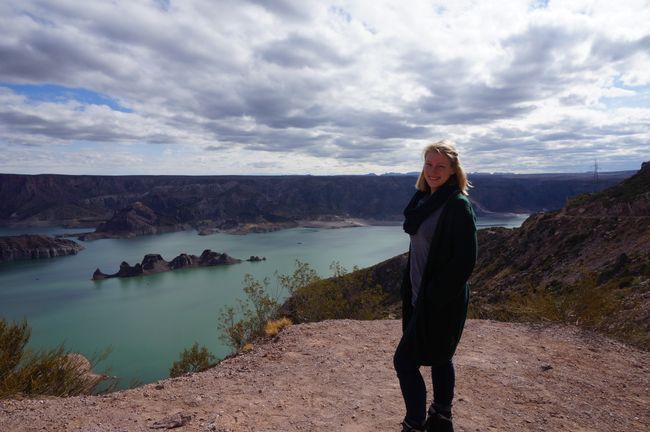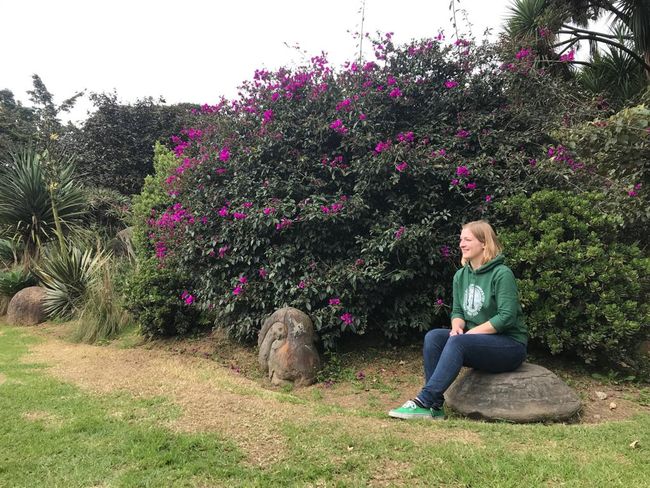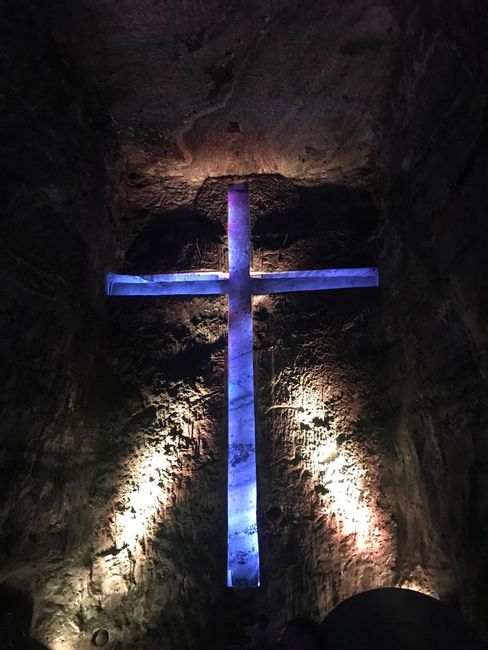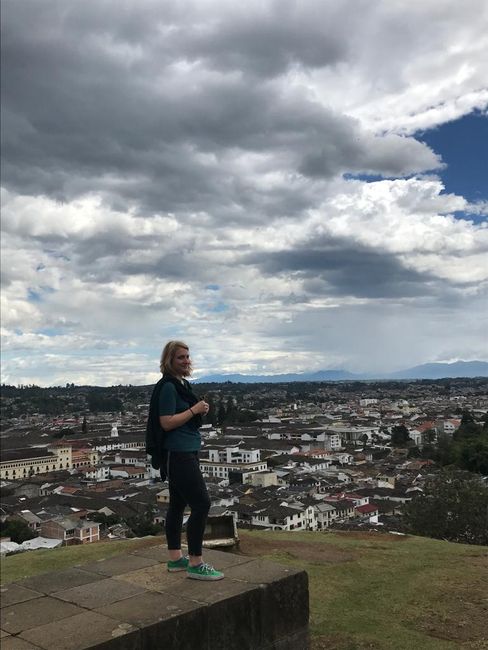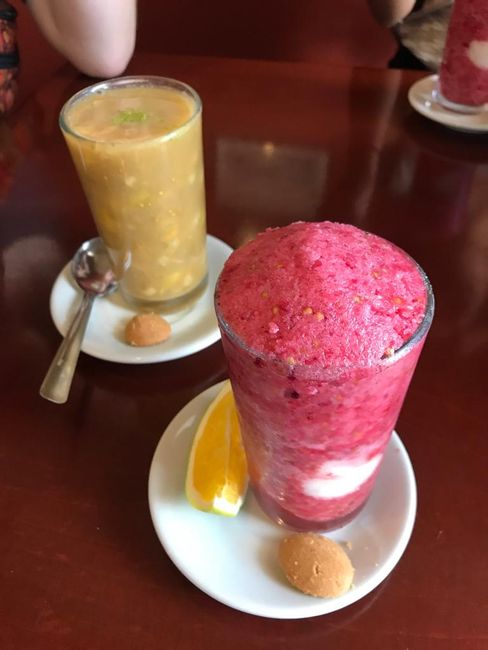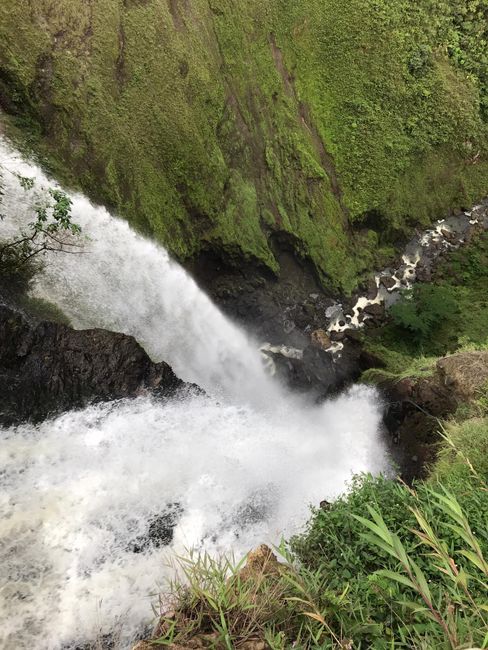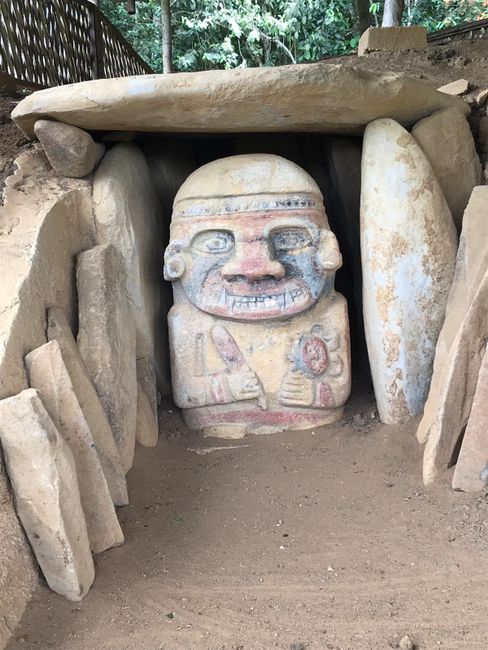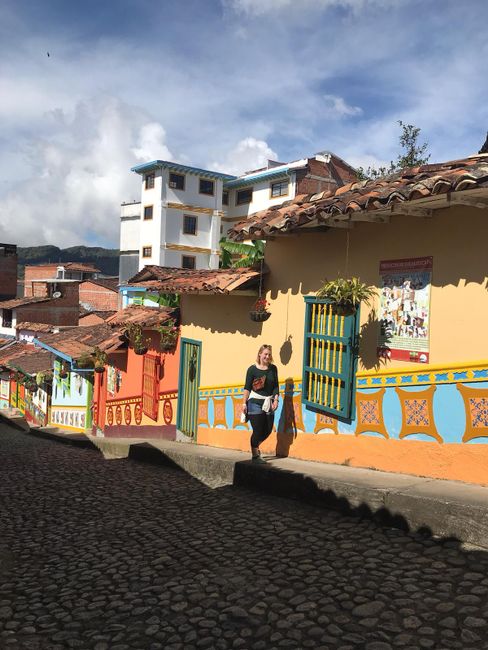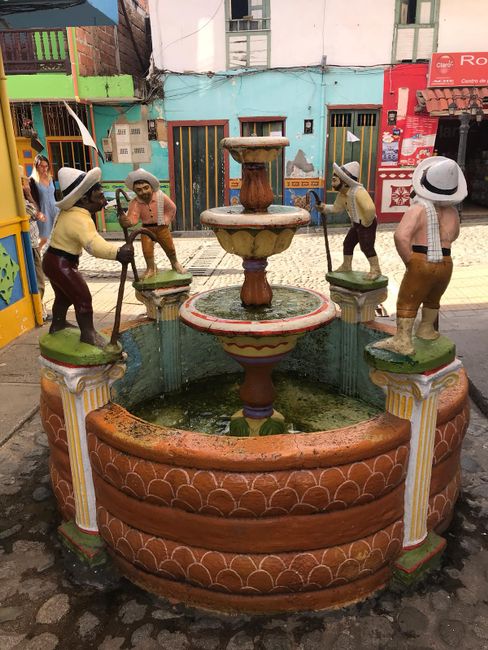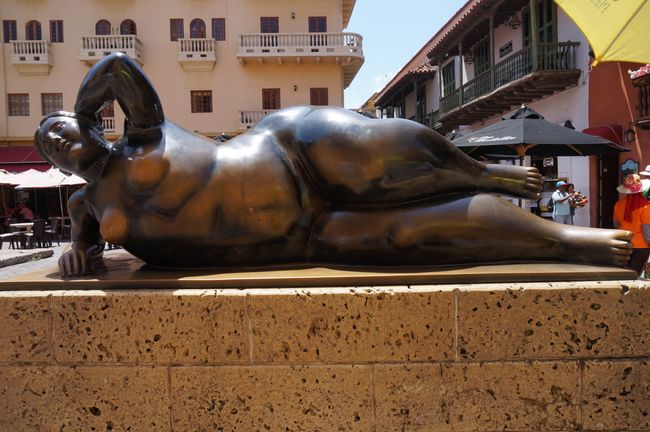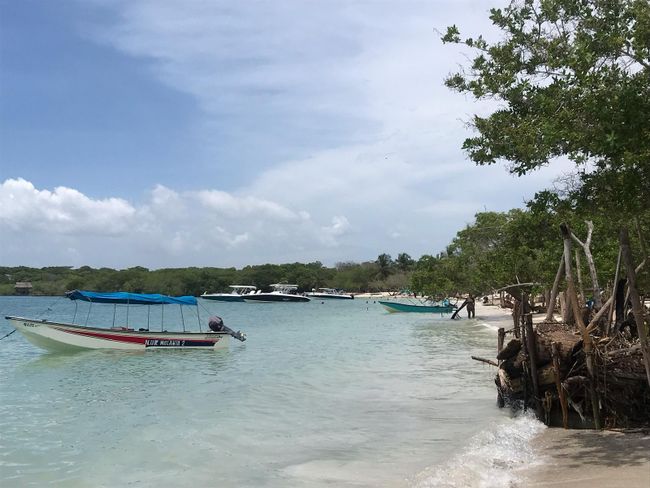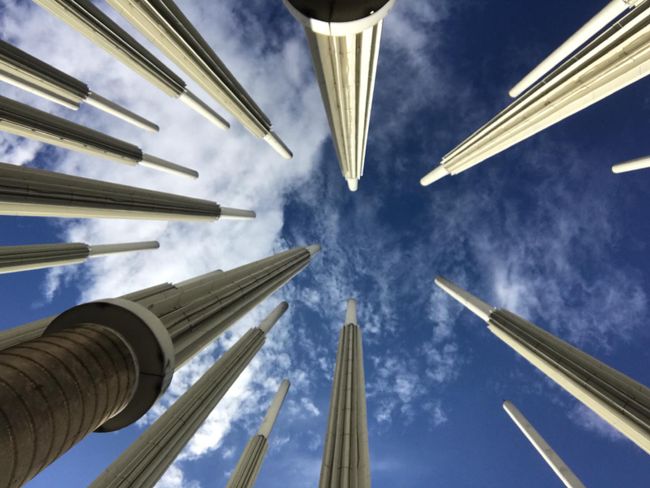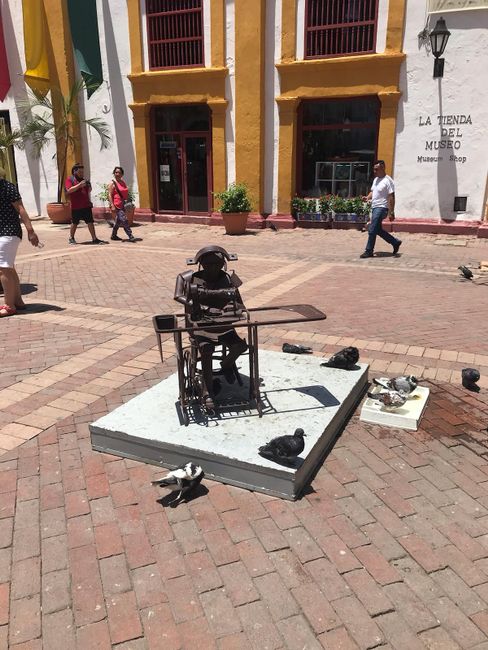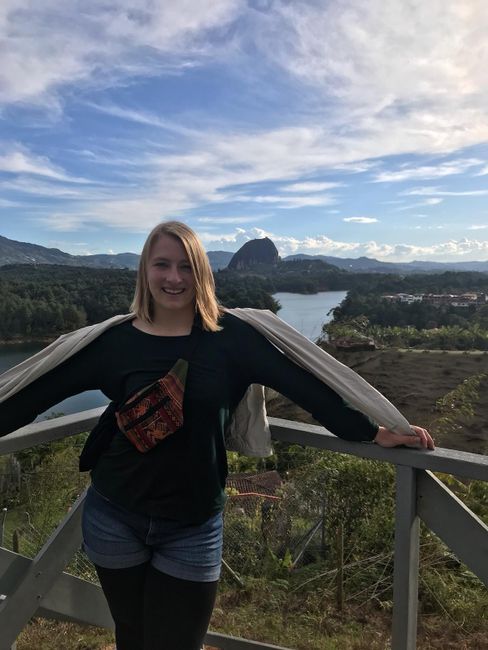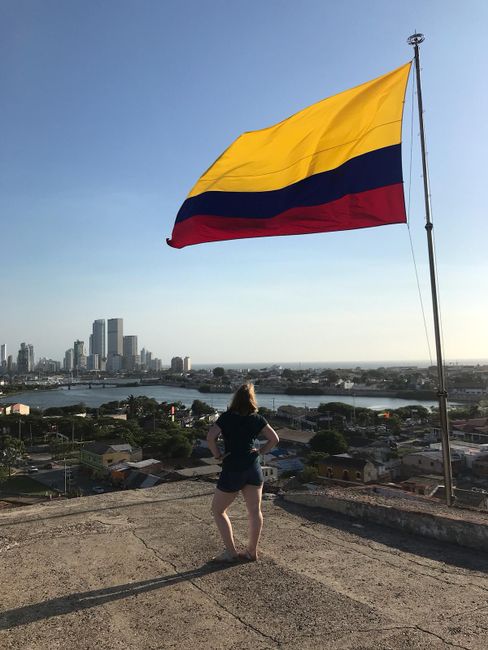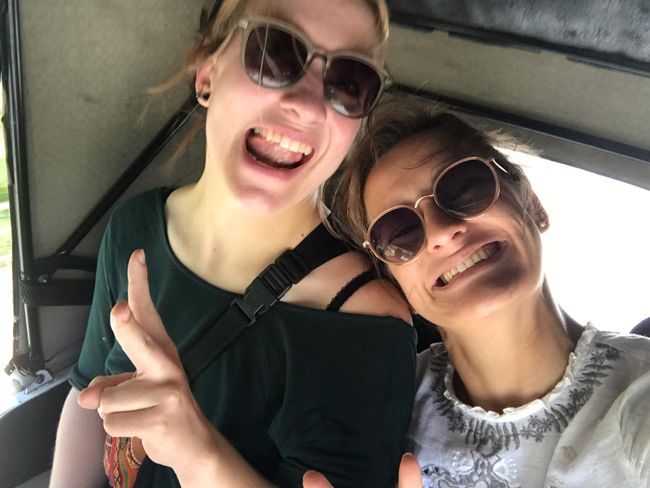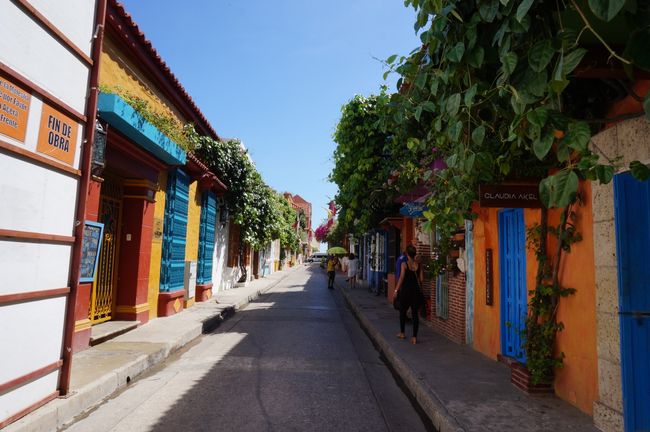¡Salsa, Cumbia y Colombia!
Publicat: 14.08.2019
Subscriu-te al butlletí
ESPANOL
Mi viaje a Colombia comenzó unida a Eva en Bogotá. Después de un intento fallido de tomar un Uber a nuestro hostel, sí, Uber es ilegal aquí y nos atraparon, tomamos un taxi a nuestro hostel. Como siempre, el viaje terminó en una discusión sobre precios,
porque en las tarifas del taxímetro supuestamente siempre se suman tarifas de aeropuerto, tarifas nocturnas y otros inventos, así que el precio después de media hora de desvío es demasiado alto. Las razones por las cuales Uber está en auge a pesar de la prohibición son obvias.
Nuestro hostel estaba ubicado en el barrio histórico de Bogotá llamado 'Candelaria'. Participamos en un tour por la ciudad bajo la lluvia, un tour de grafitis, visitamos el museo del oro e incluso asistimos al teatro, aunque ambos nos quedamos dormidos de vez en cuando. Aún no sabemos si la obra (Woyzeck de Büchner) tiene apenas trama o simplemente no la entendimos por nuestro escaso conocimiento del español.
En el Monserrate, al que se puede acceder desde 'Candelaria' por teleférico y funicular, nos dimos cuenta de la verdadera magnitud de la ciudad. Para comparar: Candelaria tiene aproximadamente el tamaño de Jena, toda Bogotá tiene aproximadamente el tamaño de Berlín, París y Roma juntos.
Con el objetivo de ver un poco más del verdadero Bogotá, hicimos una excursión al jardín botánico, al mercado dominical en Usaquén y a un restaurante en Chapinero. Finalmente, visitamos la catedral de sal y el centro del pequeño pueblo de Zipaquirá. Solo el camino de regreso dentro de la ciudad tomó una hora entero.
Desde la gran capital tomamos el bus nocturno a Popayán, donde nos recibieron en la calle con las palabras 'Bienvenidos a Colombia. ¡Bienvenidos a Popayán, la ciudad blanca!' Debido a las numerosas casas blancas, Popayán se considera 'la ciudad blanca'.
En comparación con Bogotá, Popayán es más provincial y fácil de explorar en un día. Alice, una excompañera de clase de Eva, nos puso en contacto con algunos amigos locales que nos mostraron la ciudad.
Supuestamente hay tantas frutas diferentes en Colombia que puedes probar una fruta diferente cada día durante dos años.
Aquí en Popayán probamos dos bebidas de frutas, una especie de batido frappe llamado 'Salpicón payanes' y el batido de maíz 'champús',
que recordaba a la cerveza de maíz 'chicha' elaborada en Bogotá. Como acompañamiento, comimos una especie de crisp de maíz llamada 'Carantanta'.
Continuamos en bus por una muy sinuosa carretera de grava hacia San Agustín. En el camino hacia el hostel, la policía nos detuvo. Otra vez. No, no habíamos tomado ningún Uber ilegal, íbamos a pie en el camino.
Esta vez tampoco fue la policía de tráfico, sino la policía turística, que acaba de llevar a una turista francesa a una finca y nos llevó con ellos. Después de visitar la finca, uno de los policías nos organizó un tour a caballo por tres importantes sitios arqueológicos y nos llevó a nuestro hostel. Al día siguiente hicimos la cabalgata. Aunque el amigo de nuestro policía tenía gripe, había enviado sus caballos y un amigo suyo, quien nos dio un tour en un español claro y perfecto. Nuestro guía tenía un amigo con un auto, quien podría llevarnos a tres famosas cascadas de la región. Entonces, finalmente, nos desplazamos de cascada a cascada con el amigo del amigo del amigo del policía. Sí, San Agustín es un pueblo.
En nuestro último día, visitamos el sitio arqueológico más famoso. Se nos dijo que tres horas son suficientes para explorar el parque, sin embargo, tuvimos que apresurarnos para realmente recorrer todo el parque.
Después del clima más bien frío en Bogotá, en Cali, nuestra próxima parada, finalmente nos recibió con un clima cálido.
La gran ciudad tiene, al igual que Bogotá, solo un pequeño centro turístico. Cali es conocida por tres cosas: la industria de la caña de azúcar, la serie de Netflix 'Narcos' sobre el cartel de Cali y por la salsa.
Entonces salsa el baile, no la salsa, aunque según nuestro guía turístico, el baile fue nombrado en honor a la salsa.
Después de un curso intensivo en nuestro hostel, fuimos a una fiesta de salsa con Luisa, la hermana de un conocido de Buenos Aires.
El club, que al principio estaba bastante vacío, se empezó a llenar poco a poco y cada vez más parejas se atrevían a salir a la pista de baile hasta que esta estuvo compuesta solo por parejas giro, balanceándose y bailando.
De un lugar de Narcos a otro, nuestro camino nos llevó a Medellín. El sitio del antiguo cartel de drogas de Pablo Escobar. Incluso hicimos un tour al respecto, pero como ambos no hemos visto la serie, el tour fue más bien poco espectacular. Mejor fue el tour a pie gratuito en el centro histórico, que también abordó el tema, pero lo puso en el contexto de la situación actual y el paisaje urbano. Por ejemplo, nuestro guía nos dijo que hay cuatro opiniones sobre Pablo Escobar. La primera y, a la vez, su opinión en la que Pablo Escobar es un criminal abominable. La segunda opinión, sostenida principalmente por personas que deben su casa o dinero a Pablo, para quienes Pablo Escobar fue una persona generosa. La tercera opinión, que es sostenida principalmente por jóvenes en relación con las casas y regalos de dinero, para quienes Pablo Escobar representa una especie de Robin Hood. La cuarta opinión, a la cual no se le presta atención, es de aquellos que no quieren pensar en el asunto. El tour me motiva a quizás ver la serie después de todo. De hecho, el mercado de drogas hoy en día es más grande que nunca. Sin embargo, dado que el mayor mercado está en el extranjero, es difícil para Colombia ejercer control al respecto.
Hoy, Medellín lucha por deshacerse de la reputación de ser una de las ciudades más peligrosas y por ser vista independientemente del contexto de Pablo. Así se instalaron muchas figuras de metal curiosas en Medellín. En las estatuas del artista Fernando Botero, las proporciones están cambiadas, por ejemplo, un caballo muy ancho con piernas grandes pero con una cabeza diminuta.
La última y más turística estación en Colombia fue la ciudad pirata de Cartagena con su dulce centro histórico protegido por la UNESCO. Situada en la costa caribeña, aquí no nos perdimos la gira histórica de la esclavitud ni el 'island hopping'.
Aquí en Cartagena, durante los tiempos de la esclavitud, se inventó la Cumbia. Un baile más europeo-español a la música de estilo africano. Hoy en día, la Cumbia es uno de los géneros musicales más escuchados en toda América Latina con grupos de música de México, Argentina y los países andinos.
En términos generales, se podría resumir que si Colombia fuera un menú de tres platos, solamente habríamos probado el aperitivo.
Dos semanas son suficientes para tener una impresión del país, pero también nos dan una idea de lo que aún podríamos haber visto.
De hecho, ya estoy de vuelta en Europa. Prometo que el blog de Panamá, que también se ha retrasado, se escribirá.
Saludos
Su Dory
ENGLISH
My Colombia journey started united with Eva in Bogota. After a failed attempt to take an Uber to our hostel, yes it is illegal here and we got caught, we took a cab to our hostel. As always, the trip ended in a price disagreement, because on the taxometer prices 'missed' airport taxes, night tariffs and other inventions so that the price is way too high after a half hour detour. The reasons why Uber is booming despite the ban are obvious.
Our hostel was located in the historic quarter of Bogota called 'Candelaria'. We participated in a rainy city tour, a grafiti tour. We visited the gold museum and even went to the theatre, but we both fell asleep from time to time. We still don't know if the play (Woyzeck von Büchner) has hardly any plot or we just didn't understand everything because of our poor knowledge of Spanish.
On the Monserrat, which can be reached from the 'Candelaria' by teleferico and funicular, we became aware of the actual size of the city.
For comparison: Candelaria is about the size of Jena, all Bogota roughly the size of Berlin, Paris and Rome together.
With the aim to see some more of the actual Bogota, we made an excursion to the botanical garden, to a Sunday market in Usaquen and a restaurant in Chapinero. Finally we visited the salt cathedral and the centre of the small town Zipaquirá. The way back within the city alone took a whole hour.
From the big capital we took the night bus to Popayan. We were welcomed on the street with the words 'Bienvenidos a Colombia. Bienvenidos a Popayan, la ciudad blanca!' Due to the many white houses Popayan is considered as 'la ciudad blanca', the white city.
Compared to Bogota, Popayan is more provincial and easy to explore within a day. Alice, a former classmate of Eva, brought us into contact with some of her local friends who showed us the city. There are so many different fruits in Colombia that you can try a different fruit every day for two years. Here in Popayan we tasted two fruit drinks, a kind of smothie frappé called 'Salpicón payanes' and a corn smothie called 'champús', that reminded me of the corn beer 'chicha' brewed in Bogota. As a side dish we ate some kind of corn crisp called 'Carantanta'.
We continued by bus via a very winding gravel road to San Augustin. On the way to the hostel we were stopped by the police. Again. No, we hadn't taken any illegal Uber, we were on foot. But this time it was not the traffic police but the tourist police which gave a French tourist a tour to a finca and took us with them. After visiting the finca, one of the policemen organized a horseback riding tour of three mayor archaeological sites for us and drove us to our hostel. The next day we went for the horse ride however our policeman's friend had the flu. He had sent his horses and a friend of his, who gave us a tour in a flawless, clear Spanish. Our guide had a friend with a car who could drive us to three famous waterfalls in the region. So finally,we chugged from waterfall to waterfall with the friend of the friend of the policeman's friend. Yes, San Augustin is a village. On our last day, we visited the most famous archaeological excavation site. We were told that three hours is enough to explore the park, but we had to hurry to really walk through the whole park.
After the rather cold weather in Bogota, our next stop Cali finally welcomed us with warm weather. Like Bogota the big city has only a small tourist centre. Cali is known for three things: the sugar cane industry, the Netflix series 'Narcos' regarding the former Cali cartel and for Salsa. Salsa the dance not the sauce. Even though according to our tour guide the dance was named after the sauce. After a crash course in our hostel, we went to a salsa party with Luisa, the sister of a friend from Buenos Aires. The initially rather empty club filled up bit by bit and more and more couples were adding themselves to the dance floor
until it consisted only of spinning, swaying and dancing couples.
From one Narcos venue to the next our way led us on to Medellin. The site of the former drug cartel of Pablo Escobar. We even did a tour in this respect, but since we didn't see the series, the tour was rather unspectacular for both of us. All the better was the free walking tour in the historical centre,who also covered the topic, but brought it into the context of today's situation and the cityscape. For example, our tour guide told us that today there are four opinions about Pablo Escobar.
The first opinion in whose eyes Pablo Escobar was a huge criminal.
The second opinion, mainly carried by people, who owe their house or or money to Pablo, in whose eyes Pablo Escobar was a generous person. The third opinion, which is mainly held by young people with regard to the houses and gifts of money, in whose eyes Pablo Escobar represents some kind of Robin Hood. The fourth opinion, namely no or a neutral opinion, which is mainly supported by people who do not want to think about it. The tour motivates me to have a look at the series after all. In fact, the drug market today is bigger than ever.
Nowadays, Medellin is struggling to break down the reputation of being one of the most dangerous cities and to be seen independently of the Pablo context. Thus many bizarre metal figures were set up in Medellin.
In the statues of the artist Fernando Botero the propotions are changed for example the very huge horse with wide legs but a tiny head.
The last and most touristic station in Colombia was the pirate city Cartagena with its sweet UNESCO protected historical centre. Situated on the Caribbean coast, we neither missed the historic Slavery tour nor the island hopping.Cumbia was invented here in slavery times. The rather European-Spanish dance to African influenced music is one of the most listened to music styles in Latin America today with music groups from Mexico, Argentina and the Andes countries.
Generally speaking, if Colombia was a three-course meal, we would only have tried the appetizer. Two weeks are enough to get an impression of the country, but also to get an impression of what we could have seen.
I'm already back in Europe but i will write the blog about Panama even though it s late. I promise.
Saludos como siempre,
Dory
Subscriu-te al butlletí
Respon
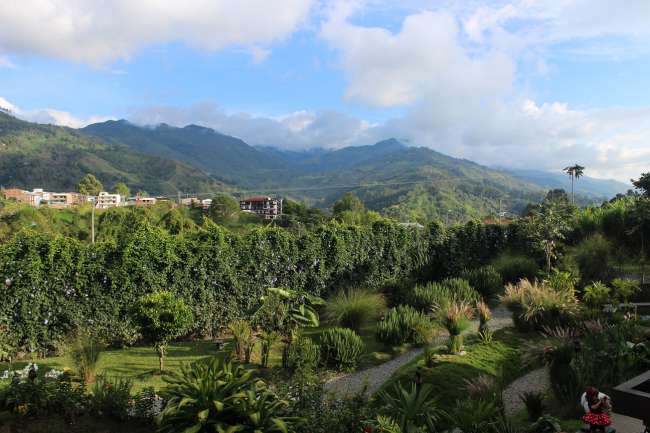
Informes de viatge Colòmbia

